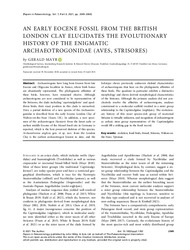An early Eocene fossil from the British London Clay elucidates the evolutionary history of the enigmatic Archaeotrogonidae (Aves, Strisores)
DOI: https://doi.org/10.1002/spp2.1392
Persistent URL: http://resolver.sub.uni-goettingen.de/purl?gldocs-11858/9730
Persistent URL: http://resolver.sub.uni-goettingen.de/purl?gldocs-11858/9730
Mayr, Gerald, 2021: An early Eocene fossil from the British London Clay elucidates the evolutionary history of the enigmatic Archaeotrogonidae (Aves, Strisores). In: Papers in Palaeontology, Band 7, 4: 2049 - 2064, DOI: 10.1002/spp2.1392.
 |
Dokument öffnen: |
Archaeotrogons have long been known from late Eocene and Oligocene localities in France, where limb bones are abundantly represented. The phylogenetic affinities of these birds, however, have remained elusive. Although archaeotrogons are now considered to be representatives of the Strisores, the clade including ‘caprimulgiform’ and apodiform birds, their exact position in this clade is unresolved. Here, a partial skeleton of a new species of the Archaeotrogonidae is described from the early Eocene London Clay of Walton‐on‐the‐Naze (Essex, UK). In addition, a new specimen of the archaeotrogon Hassiavis from the latest early or earliest middle Eocene of the Messel fossil site in Germany is reported, which is the best preserved skeleton of this species. Archaeodromus anglicus gen. et sp. nov. from the London Clay is the earliest archaeotrogon known to date, and the holotype shows previously unknown skeletal characteristics of archaeotrogons that bear on the phylogenetic affinities of these birds. The quadrate in particular exhibits a distinctive morphology and shows derived morphological characteristics of the Strisores. Although the primary analysis did not conclusively resolve the affinities of archaeotrogons, analyses constrained to a molecular scaffold resulted in a sister group relationship to the Caprimulgidae (nightjars). The evolutionary history of this most species‐rich group of nocturnal Strisores is virtually unknown, and recognition of archaeotrogons as archaic stem group representatives of the Caprimulgidae would fill a striking gap in the fossil record.
Statistik:
ZugriffsstatistikSammlung:
This is an open access article under the terms of the Creative Commons Attribution License, which permits use, distribution and reproduction in any medium, provided the original work is properly cited.

